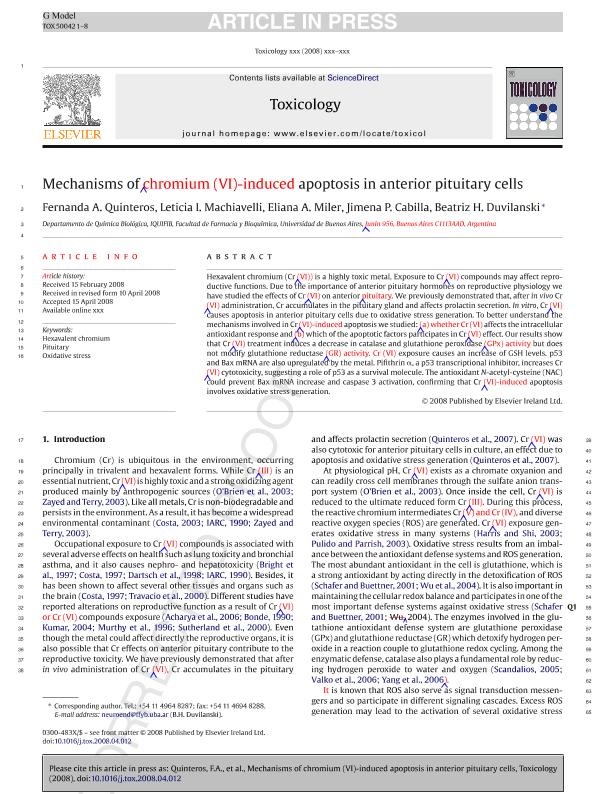Artículo
Mechanisms of Chromium VI-induced apoptosis in anterior pituitary cells
Quinteros, Alnilan Fernanda; Machiavelli, Leticia Ines ; Miler, Eliana Andrea
; Miler, Eliana Andrea ; Cabilla, Jimena Paula
; Cabilla, Jimena Paula ; Duvilanski, Beatriz Haydee
; Duvilanski, Beatriz Haydee
 ; Miler, Eliana Andrea
; Miler, Eliana Andrea ; Cabilla, Jimena Paula
; Cabilla, Jimena Paula ; Duvilanski, Beatriz Haydee
; Duvilanski, Beatriz Haydee
Fecha de publicación:
12/2008
Editorial:
Elsevier Ireland
Revista:
Toxicology
ISSN:
0300-483X
Idioma:
Inglés
Tipo de recurso:
Artículo publicado
Clasificación temática:
Resumen
Hexavalent chromium (Cr (VI)) is a highly toxic metal. Exposure to Cr (VI) compounds may affect reproductive functions. Due to the importance of anterior pituitary hormones on reproductive physiology we have studied the effects of Cr (VI) on anterior pituitary. We previously demonstrated that, after in vivo Cr (VI) administration, Cr accumulates in the pituitary gland and affects prolactin secretion. In vitro, Cr (VI) causes apoptosis in anterior pituitary cells due to oxidative stress generation. To better understand the mechanisms involved in Cr (VI)-induced apoptosis we studied: (a) whether Cr (VI) affects the intracellular antioxidant response and (b) which of the apoptotic factors participates in Cr (VI) effect. Our results show that Cr (VI) treatment induces a decrease in catalase and glutathione peroxidase (GPx) activity but does not modify glutathione reductase (GR) activity. Cr (VI) exposure causes an increase of GSH levels. p53 and Bax mRNA are also upregulated by the metal. Pifithrin alpha, a p53 transcriptional inhibitor, increases Cr (VI) cytotoxicity, suggesting a role of p53 as a survival molecule. The antioxidant N-acetyl-cysteine (NAC) could prevent Bax mRNA increase and caspase 3 activation, confirming that Cr (VI)-induced apoptosis involves oxidative stress generation.
Palabras clave:
hexavalent chromium
,
apoptosis
,
anterior pituitar cells
Archivos asociados
Licencia
Identificadores
Colecciones
Articulos(INBIOMED)
Articulos de INSTITUTO DE INVESTIGACIONES BIOMEDICAS
Articulos de INSTITUTO DE INVESTIGACIONES BIOMEDICAS
Articulos(IQUIFIB)
Articulos de INST.DE QUIMICA Y FISICO-QUIMICA BIOLOGICAS "PROF. ALEJANDRO C. PALADINI"
Articulos de INST.DE QUIMICA Y FISICO-QUIMICA BIOLOGICAS "PROF. ALEJANDRO C. PALADINI"
Citación
Quinteros, Alnilan Fernanda; Machiavelli, Leticia Ines; Miler, Eliana Andrea; Cabilla, Jimena Paula; Duvilanski, Beatriz Haydee; Mechanisms of Chromium VI-induced apoptosis in anterior pituitary cells; Elsevier Ireland; Toxicology; 249; 2-3; 12-2008; 109-115
Compartir
Altmétricas



